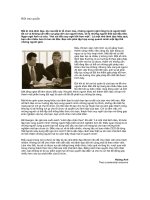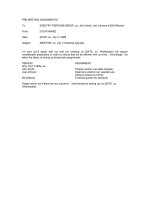Tài liệu FINANCIAL SYSTEMS & ANALYSIS pdf
Bạn đang xem bản rút gọn của tài liệu. Xem và tải ngay bản đầy đủ của tài liệu tại đây (66.16 KB, 12 trang )
FINANCIAL SYSTEMS & ANALYSIS
INVENTORY & CASH
INVENTORY
•
Objectives of control
Inventory level are in keeping with the needs of
•
Production of raw material
•
Customer demand (finished goods)
Inventory level are not
•
Excessive
•
Too low (stockouts)
Value for money is achieved
Goods and services are what was ordered
Quality goods and services delivered are satisfactorily
Liabilities are recorded completely and accurately
Only valid liabilities are paid
Liabilities are paid in sensible, commercial timescale
Inventory systems
Process Risks Possible control procedure
Inventory arrives because it
has been purchased, or
sales has been returned
•Inventory stolen at arrival
•
New purchases mixed up
with returns
•Poor quality inventory
accepted
•
Inventory accepted that
was never ordered
•
No records was made of
its arrival
1. All goods inwards
received at set locations
and signed for / logged
in by stores manager
2. All returns sent to
returns department for
checking
3. See purchase cycle
Inventory is stored until
needed
•
Poor storage conditions
lead to damaged inventory
•Inventory items not used
before their useful life ends
•
Inventory stolen from
storage area
1. Storage area filled with
sprinklers, fire alarms,
temperature controls
2. Inventory rotated to
ensure FIFO usage
where relevance
3. Valuable inventories
locked away and
inventory areas limited
to single exit (security)
Process Risks Possible control procedure
Raw materials leave stores,
to be used in production
•
Material over ordered to
enable theft
1. All requisitions from
stores to have signed
authorization from
production manager
2. Use standard quantity
requirements
Finished goods leave
because they have been
sold
•Wrong goods sent
•
Goods being stolen (no
real sale)
•Poor quality sent
•
Records not updated
1. See sales cycle (Goods
despatched)
Goods leave because they
are being returned to
supplier
•
Returned goods actually
being stolen
See Purchase returns
Process Risks Possible control procedure
An inventory count is
performed (may be
monthly /annually)
•
Counting lacks
accuracy
•
Staff lied about amount
counted to cover their
theft
•
Inventory record lost
during count
•Inventory wrongly
counted because it is
moved during count
1. All counted areas to be marked
as completed
2. Managers to check by doing
random second counts
3. Staff do not count areas that
they are usually responsible
4. Counting done in pairs
5. Inventory sheets sequenced and
counters sign out /in the count
sheets
6. All inventory movements during
counts authorized by
management
7. Closure during inventory
accounts to avoid problems









